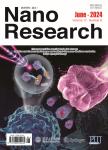Black phosphorus inverter devices enabled by in-situ aluminum surface modification
作者机构:School of Physics and Optoelectronic Engineering Nanjing University of Information Science & Technology Nanjing 210044 China Department of Physics National University of Singapore Singapore 117542 Singapore SZU-NUS Collaborative Innovation Center for Optoelectronic Science and Technology Shenzhen University Shenzhen 518060 China Department of Chemistry National University of Singapore Singapore 117543 Singapore School of Physics and Electronics Central South University Changsha 410083 China National University of Singapore (Suzhou) Research Institute Suzhou 215123 China
出 版 物:《Nano Research》 (纳米研究(英文版))
年 卷 期:2019年第12卷第3期
页 面:531-536页
核心收录:
学科分类:0808[工学-电气工程] 0809[工学-电子科学与技术(可授工学、理学学位)] 07[理学] 0805[工学-材料科学与工程(可授工学、理学学位)] 0702[理学-物理学]
基 金:National Natural Science Foundation of China (Nos. 21573156 and 21872100) Natural Science Foundation of Jiangsu Province (No. BK20170005) Singapore MOE Grants R143-000-652-112 and R143-000-A43- 114 Fundamental Research Foundation of Shenzhen (No. JCYJ20170817100405375)
主 题:black phosphorus aluminum surface doping electron mobility inverter
摘 要:Two-dimensional black phosphorus (BP) generally exhibits a hole-dominated transport characteristic when configured as field-effect transistor devices. The effective control of charge carrier type and concentration is very crucial for the application of BP in complementary electronics. Herein, we report a facile and effective electron doping methodology on BP, through in situ surface modification with aluminum (Al). The electron mobility of few-layer BP is found to be largely enhanced to ~ 10.6 cm^2·V^–1·s^–1 by over 6 times after aluminum modification. In situ photoelectron spectroscopy characterization reveals the formation of Al–P covalent bond at the interface, which can also serve as local gate to tune the transport properties in BP layers. Finally, a spatially-controlled aluminum doping technique is employed to establish a p–n homojunction on a single BP flake, and hence to realize the complementary inverter devices, where the highest gain value of ~ 33 is obtained.



